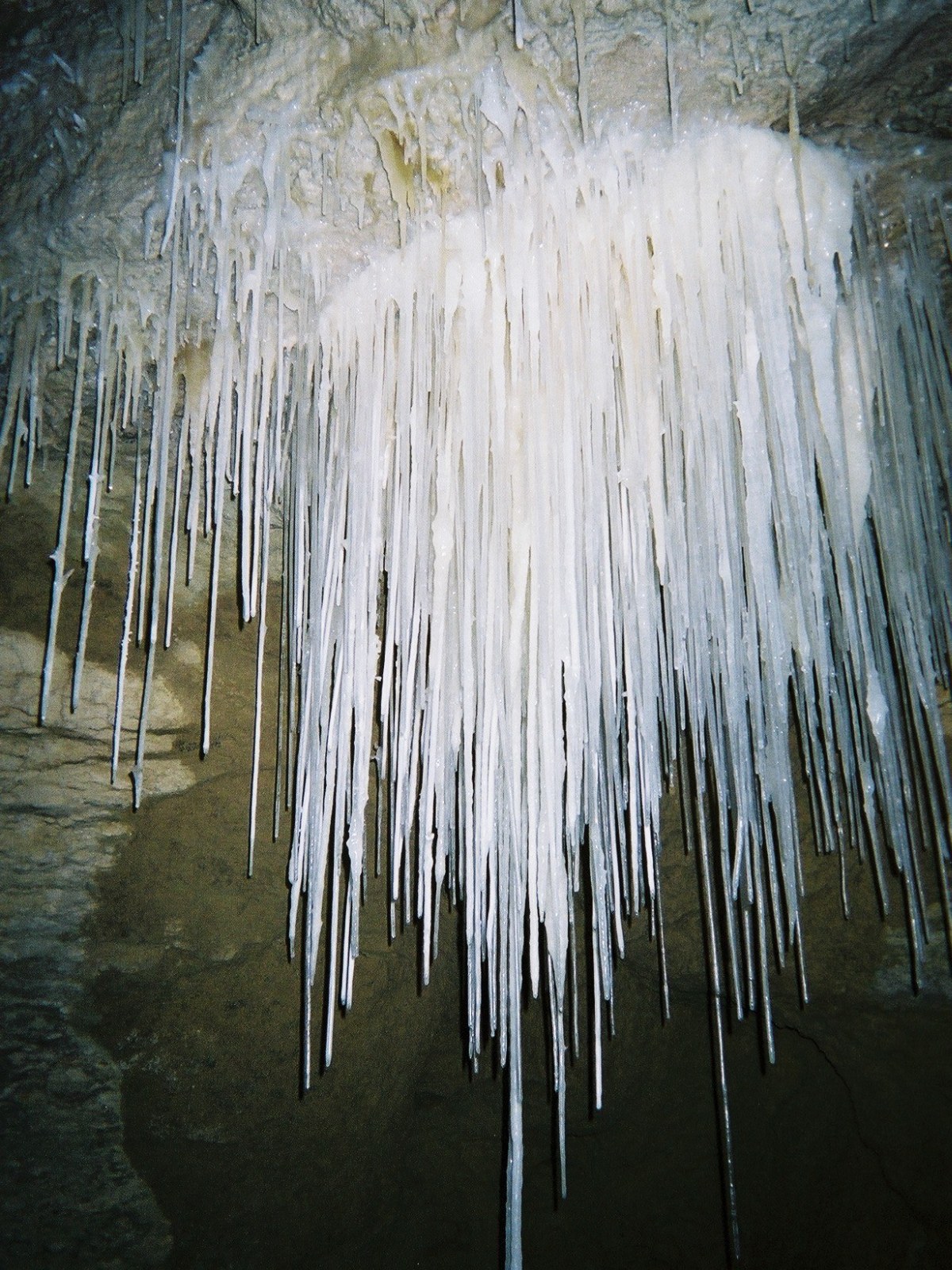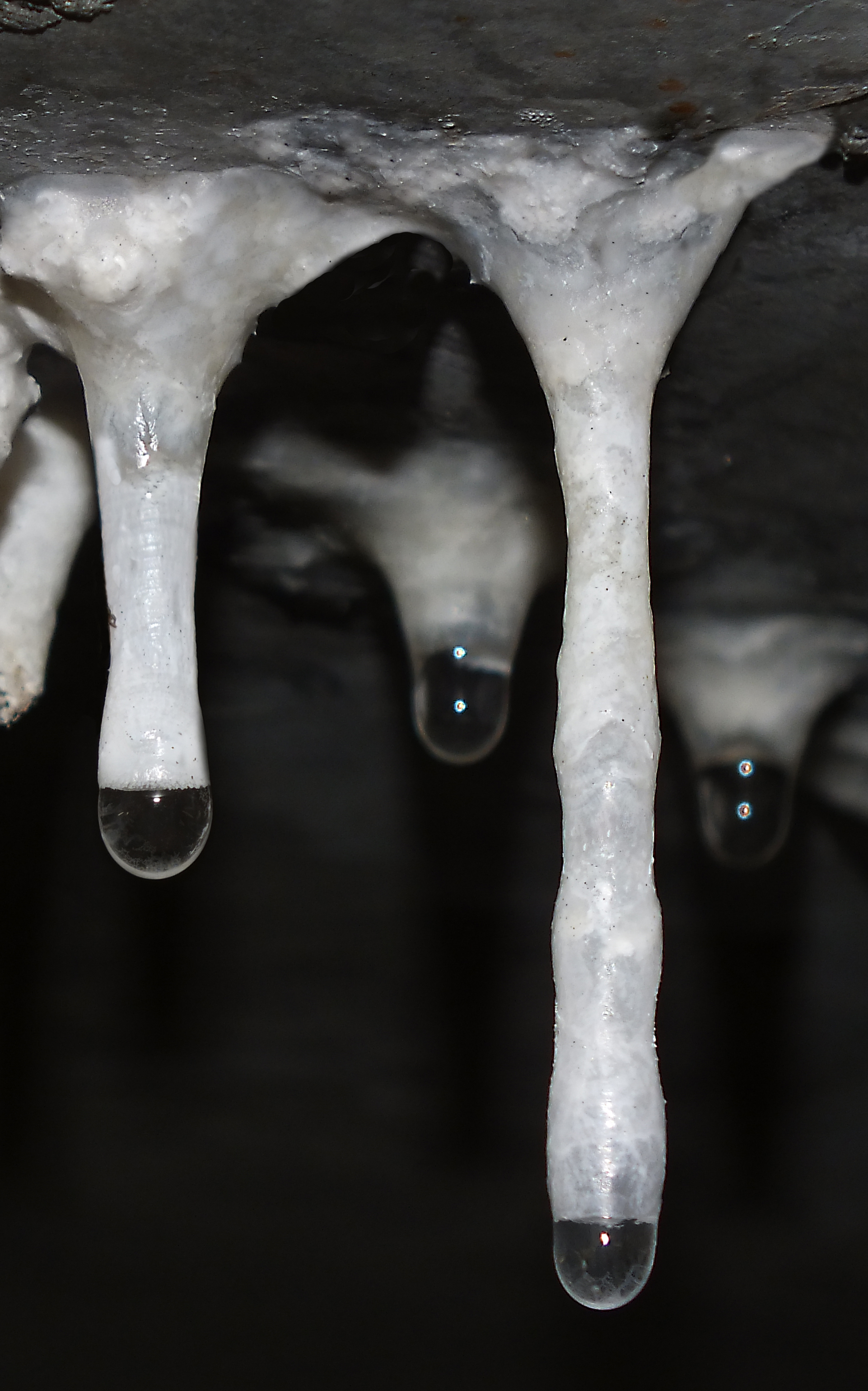Soda Straws on:
[Wikipedia]
[Google]
[Amazon]

 A soda straw (or simply straw) is a
A soda straw (or simply straw) is a


Showcaves.com definition and explanationA photo of some amazing soda straws in south eastern France
{{Caves Speleothems

 A soda straw (or simply straw) is a
A soda straw (or simply straw) is a speleothem
A speleothem (; ) is a geological formation made by mineral deposits that accumulate over time in natural caves. Speleothems most commonly form in calcareous caves due to carbonate dissolution reactions. They can take a variety of forms, depen ...
in the form of a hollow mineral
In geology and mineralogy, a mineral or mineral species is, broadly speaking, a solid substance with a fairly well-defined chemical composition and a specific crystal structure that occurs naturally in pure form.John P. Rafferty, ed. (2011): Mi ...
cylindrical
A cylinder () has traditionally been a Solid geometry, three-dimensional solid, one of the most basic of curvilinear geometric shapes. In elementary geometry, it is considered a Prism (geometry), prism with a circle as its base.
A cylinder may ...
tube. They are also known as tubular stalactites. Soda straws grow in places where water leaches slowly through cracks in rock, such as on the roofs of cave
Caves or caverns are natural voids under the Earth's Planetary surface, surface. Caves often form by the weathering of rock and often extend deep underground. Exogene caves are smaller openings that extend a relatively short distance undergrou ...
s. Soda straws in caves rarely grow more than a few millimetres per year and may average one tenth of a millimetre per year.Hill, C A, and Forti, P, (1997). "Speleothem Growth Rates", Cave Minerals of the World, (2nd edition). untsville, Alabama: National Speleological Society Inc.pp 285 - 287 A soda straw can turn into a stalactite
A stalactite (, ; , ) is a mineral formation that hangs from the ceiling of caves, hot springs, or man-made structures such as bridges and mines. Any material that is soluble and that can be deposited as a colloid, or is in suspension (chemistry ...
if the hole at the bottom is blocked, or if the water begins flowing on the outside surface of the hollow tube. Soda straws can also form outside the cave environment on exposed concrete
Concrete is a composite material composed of aggregate bound together with a fluid cement that cures to a solid over time. It is the second-most-used substance (after water), the most–widely used building material, and the most-manufactur ...
surfaces as a type of calthemite
Calthemite is a secondary deposit, derived from concrete, Lime (material), lime, Mortar (masonry), mortar or other calcareous material outside the cave environment.Smith, G.K. (2016). "Calcite straw stalactites growing from concrete structures" ...
, growing significantly faster than those formed on rock.
Formation
These tubes form whencalcium carbonate
Calcium carbonate is a chemical compound with the chemical formula . It is a common substance found in Rock (geology), rocks as the minerals calcite and aragonite, most notably in chalk and limestone, eggshells, gastropod shells, shellfish skel ...
or calcium sulfate
Calcium sulfate (or calcium sulphate) is an inorganic salt with the chemical formula . It occurs in several hydrated forms; the anhydrous state (known as anhydrite) is a white crystalline solid often found in evaporite deposits. Its dihydrate ...
dissolved in the water comes out of solution and is deposited. In soda straws, as each drop hovers at the tip, it deposits a ring of mineral at its edge. It then falls and a new drop takes its place. Each successive drop of water deposits a little more mineral before falling, and eventually a tube is built up. Stalagmite
A stalagmite (, ; ; )
is a type of rock formation that rises from the floor of a cave due to the accumulation of material deposited on the floor from ceiling drippings. Stalagmites are typically composed of calcium carbonate, but may consist ...
s or flowstone
Flowstones are sheetlike deposits of calcite or other carbonate minerals, formed where water flows down the walls or along the floors of a cave. They are typically found in "solution caves", in limestone, where they are the most common speleothe ...
may form where the water drops hit the cave floor.
Soda straws are some of the most fragile of speleothems. Like helictite
A helictite is a speleothem (cave-formed mineral) found in a Solution cave, limestone cave that changes its axis from the vertical at one or more stages during its growth. Helictites have a curving or angular form that looks as if they were gro ...
s, they can be easily crushed or broken by the slightest touch. Because of this, soda straws are rarely seen within arm's reach in show cave
A show cave—also called tourist cave, public cave, and, in the United States, commercial cave—is a cave which has been made accessible to the public for guided visits.
Definition
A show cave is a cave that has been made accessible to ...
s or others with unrestricted access. Kartchner Caverns
Kartchner Caverns State Park is a state park of Arizona, United States, featuring a show cave with of passages. The park is located south of the town of Benson and west of the north-flowing San Pedro River. Long hidden from view, the cavern ...
in southern Arizona has well-preserved soda straws because of its recent discovery in 1974 and highly regulated traffic.
Outside the cave environment
Straws can also form beneath man-made structures and grow significantly faster than in the naturalcave
Caves or caverns are natural voids under the Earth's Planetary surface, surface. Caves often form by the weathering of rock and often extend deep underground. Exogene caves are smaller openings that extend a relatively short distance undergrou ...
environment.Hill, C A, and Forti, P, (1997). Cave Minerals of the World, (2nd edition). untsville, Alabama: National Speleological Society Inc.pp 217 and 225Smith, G.K., (2016). “Calcite Straw Stalactites Growing From Concrete Structures”, Cave and Karst Science, Vol.43, No.1, P.4-10, (April 2016), British Cave Research Association, . These forms are classified as calthemite
Calthemite is a secondary deposit, derived from concrete, Lime (material), lime, Mortar (masonry), mortar or other calcareous material outside the cave environment.Smith, G.K. (2016). "Calcite straw stalactites growing from concrete structures" ...
s as opposed to the speleothems growing in natural environments. Their chemistry differs from those found in caves because they are derived from concrete
Concrete is a composite material composed of aggregate bound together with a fluid cement that cures to a solid over time. It is the second-most-used substance (after water), the most–widely used building material, and the most-manufactur ...
, lime, mortar or other calcareous material.Macleod, G, Hall, A J and Fallick, A E, (1990). "An applied mineralogical investigation of concrete degradation in a major concrete road bridge". Mineralogical Magazine, Vol.54, 637–644.
Calthemite soda straws have been recorded as growing up to per day in length, which is hundreds of times faster than speleothem soda straw growth rates typically averaging 2 mm or less per year.
Calthemite straws are on average just 40% the mass per unit length of speleothem straws of equivalent external diameter. This is because calthemite straws have a thinner wall thickness and less-dense calcium carbonate structure compared to speleothem straws.Smith, G.K., (2021). "Comparison of calthemite and speleothem straw stalactites, and environmental conditions influencing straw diameter", Cave and Karst Science, Transactions of the British Cave Research Association, Vol.48(1), 3–11
A calthemite straw can vary in outside diameter as it grows in length. Changes in diameter can take a matter of days or weeks and are due to changes in drip rate over time. Slow dripping calthemite straws tend to be slightly larger in diameter than fast-dripping straws. As a comparison, because of the much "slower growth rate of speleothem (cave) straws, there is more chance that fluctuation in drip rate may be averaged out and the straw external diameter remains reasonably constant."


References
External links
Showcaves.com definition and explanation
{{Caves Speleothems